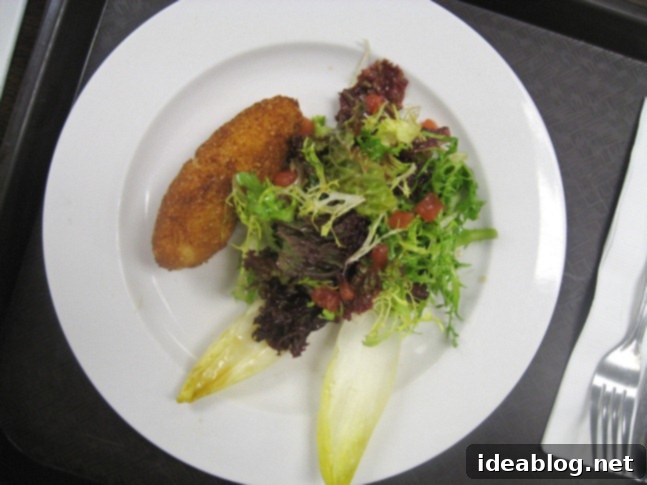Mastering French Culinary Arts: A Day of Brandade, Lamb Tenderloin, and Laminated Pastries
Our return to the kitchen this week marked the beginning of another intense yet incredibly fulfilling chapter in our culinary education. The day, though undeniably long, was brimming with new techniques and profound insights into the intricate world of French gastronomy. We embarked on our culinary expedition with an elegant first course: a fresh, vibrant salad, a welcome sight after some time, served alongside a truly exceptional brandade croquette. This delightful appetizer set a high bar for the day’s learning, combining classic French flavors with an approachable, comforting texture.
Brandade, for those unfamiliar with this exquisite preparation, is a classic emulsion crafted from carefully desalted cod, rich olive oil, and in our rendition, a touch of luxurious cream. This was my inaugural experience working with, and perhaps even tasting, salted cod. I was pleasantly surprised by its distinct, robust flavor profile; rather than being overpowering, it lent a delightful depth to the dish that I found quite appealing and memorable. The process of desalinating the cod is crucial for achieving the perfect balance, often involving multiple changes of cold water over an extended period, ensuring the fish is perfectly seasoned without being excessively salty. This meticulous preparation is key to unlocking the true potential of this traditional ingredient.
Our brandade croquettes were a masterclass in texture and flavor balance. The foundation consisted of beautifully cooked potatoes, which were then combined with the desalted cod, gently poached in a mixture of milk and water. Poaching in milk not only helps to tenderize the cod but also subtly mellows its inherent intensity, resulting in a more refined and palatable flavor. This delicate mixture was then emulsified with generous amounts of high-quality olive oil, a splash of cream for added richness and a velvety mouthfeel, and finely minced garlic for aromatic complexity. The goal was to achieve a consistency akin to thick, velvety mashed potatoes – smooth enough to be pliable, yet firm enough to hold its shape. Once prepared, we meticulously shaped the mixture into elegant quenelles, which were then chilled thoroughly. This chilling step is vital, as it firms up the croquettes, preventing them from falling apart during the delicate breading and high-heat frying stages. Finally, each quenelle was carefully breaded with a light coating and deep-fried to a perfect golden crisp, delivering a delightful textural contrast with its creamy, flavorful interior. The result was a harmonious blend of savory seafood, earthy potato, and a satisfying crunch.
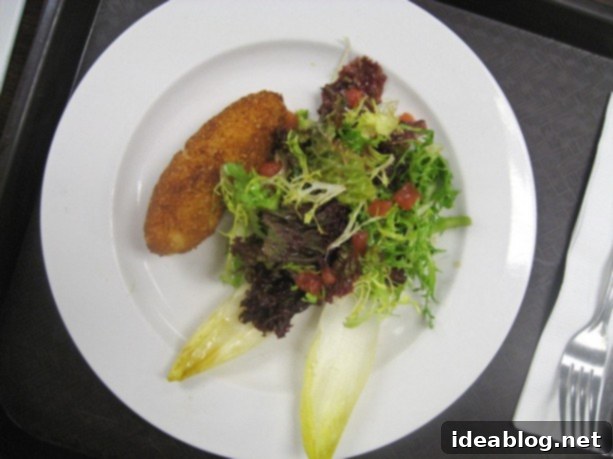
Moving on to the main course, we were once again introduced to another novel potato preparation – a testament to the endless versatility of this humble tuber in French cuisine! It continues to amaze me how many distinct potato dishes there are left to discover, especially given that we’ve already prepared well over two dozen variations throughout our program. From purées to gratins, each iteration showcases a different facet of the potato’s character. I’m certain there are countless more culinary treasures awaiting us. These particular potatoes, known as pommes roesti (visible at the top of the picture), began their journey as perfectly baked potatoes. After cooling sufficiently, they were meticulously peeled, coarsely grated to create texture, and then combined with a delectable blend of rich Gruyère cheese, melted butter, beautifully rendered bacon lardons for a smoky depth, and finely sweated onions for a subtle sweetness. This combination creates a profoundly flavorful and aromatic base for the roesti.
This flavorful mixture was then carefully molded into a compact shape, typically a thick disc or rectangle, and subsequently chilled. Chilling is paramount here, as it allows the fats to solidify and the ingredients to bind together firmly, ensuring the roesti maintains its integrity during the high-heat cooking process. Before cooking, the chilled potato mixture was lightly dusted with flour, which contributes to a delicate, crispy crust when seared. It was then transferred to a non-stick pan and seared until golden brown and gloriously crispy on both sides, creating a beautiful contrast between the outer crust and the tender, cheesy interior. The result was truly magnificent – a crunchy exterior giving way to a tender, cheesy, and savory interior that was incredibly satisfying. This preparation quickly became one of my absolute favorite potato dishes we’ve explored thus far, offering a comforting yet sophisticated alternative to more common potato preparations. Its rich flavors and satisfying textures make it an ideal accompaniment for a variety of main dishes, showcasing how simple ingredients can be transformed through expert technique.
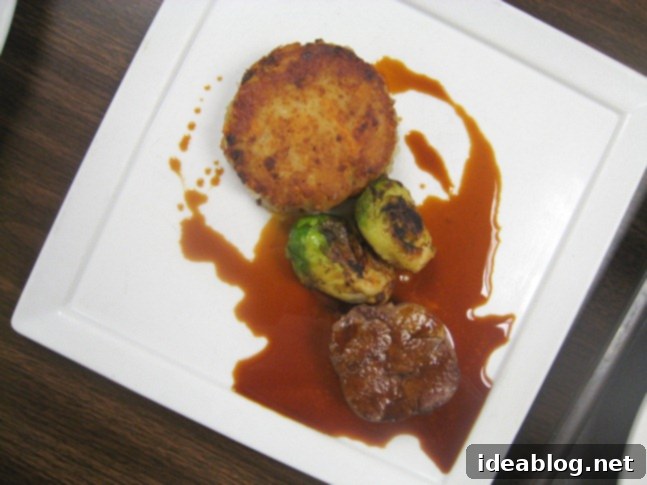
Our exquisite pommes roesti was perfectly paired with beautifully pan-roasted Brussels sprouts, caramelized to perfection to enhance their natural sweetness and slight bitterness, a reduction of rich lamb jus, and the true star of the plate: lamb tenderloin. I honestly cannot recall if I had ever had lamb tenderloin before, but its delicate flavor and incredibly tender texture left a lasting impression. Unlike some other lamb cuts that can be quite robust and gamey, the tenderloin offered a subtle, almost buttery flavor that I found highly enjoyable and refined. It’s a cut known for its tenderness and mildness, making it a luxurious choice for fine dining. Given that individual lamb tenderloins are inherently quite small, a unique and clever technique was employed to achieve a uniform, substantial portion suitable for a main course. We took four individual tenderloin pieces, carefully pressed them together, and then tightly wrapped them in culinary-grade plastic wrap to mold them into a single, cohesive log. This method ensures a consistent shape and allows for even cooking, resulting in perfectly round medallions when sliced.
The real marvel of this technique came next: we sliced the molded log into medallions and seared these pieces directly with the plastic wrap still intact. This seemingly counter-intuitive step is a brilliant professional trick; the specialized plastic wrap acts as a temporary mold, helping to maintain the perfect circular shape of the medallions and preventing them from seizing up or deforming during the initial searing process. It also helps to retain moisture within the meat, contributing to its tenderness. It’s important to note that the specialized plastic wrap used in professional kitchens is designed to withstand high temperatures without melting or leaching any harmful substances into the food, ensuring both safety and culinary precision. Once seared to a beautiful golden-brown on both sides, creating a delicious crust, the plastic wrap is carefully removed, and the medallions finish cooking to their desired doneness. This technique is a fantastic example of how professional chefs employ clever methods to achieve aesthetic perfection and consistent results, elevating a simple ingredient to a gourmet experience. The accompanying lamb jus, simmered down to an intense, savory elixir, beautifully complemented the tender meat, providing a rich umami depth, while the pan-roasted Brussels sprouts added a touch of vibrant green, a delightful texture, and a pleasant bitterness to cut through the richness of the dish.
And finally, to conclude our savory courses, we indulged in another delightful new dessert: a tart known as Tarte Florentin (specifically without the ‘e’ at the end). Despite its intriguing name, I’m afraid the exact etymology or reason for this particular appellation escapes my memory at the moment! However, its origins likely hint at a connection to Florence, or at least a style inspired by Italian confectionery, known for its lavish use of nuts and candied fruits, suggesting a rich, celebratory dessert.
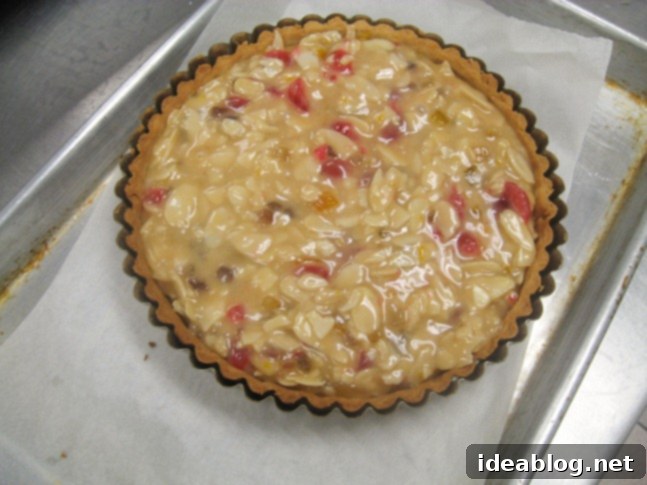
This tart proved to be a wonderfully sweet creation, yet it pleasantly exceeded my expectations, offering a more balanced and nuanced sweetness than initially anticipated. To describe it, I would say it shares similarities with a classic caramel tart, but with the distinct and delightful additions of toasted sliced almonds and an assortment of finely diced candied fruits, which provide both texture and bursts of concentrated flavor. The preparation began with a perfectly blind-baked crust, ensuring a crisp, sturdy foundation that would not become soggy from the rich filling. Into this, we poured a rich, luscious caramel, painstakingly crafted to the “soft-ball” stage – a crucial point in caramel making that determines its final texture. This caramel was made from a careful blend of cream for silkiness, granulated sugar for sweetness, and fragrant honey, which imparts a unique depth of flavor and helps prevent crystallization. To this bubbling caramel, we then incorporated a small amount of flour, which aids in setting the filling and giving it body, along with an abundance of sliced almonds and the colorful, chewy candied fruit. The combination of these ingredients creates a textural symphony within the tart, from the yielding caramel to the crunchy almonds and the delightful chewiness of the fruit, all resting on a crisp pastry base.
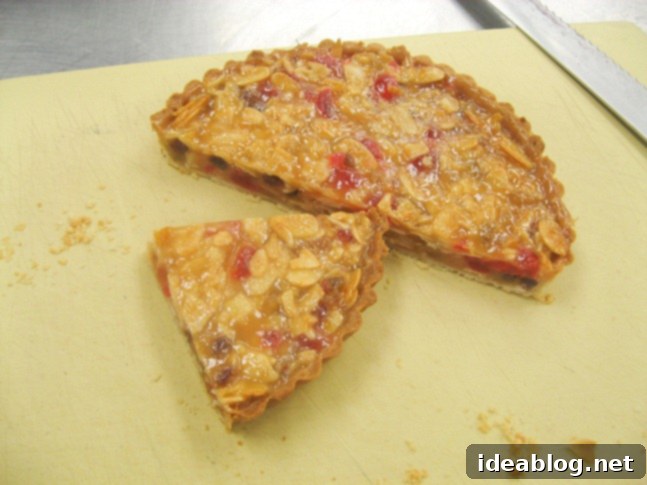
The tart was then baked for a remarkably short duration, just long enough for the filling to set and for the almonds to develop a beautiful, golden hue, before being promptly transferred to the refrigerator to chill and firm up completely. One fascinating aspect of our pastry training, particularly in contrast to our counterparts who might rely solely on modern tools, is our method for testing caramel doneness. Unlike using precise candy thermometers, which provide exact temperature readings and eliminate guesswork, our technique involves a more tactile, old-world approach. We first dip our hands into ice water to cool our fingers, and then, with surprising bravery, quickly grab a small amount of the boiling caramel to test its consistency between our fingers. The first time I was instructed to do this, the idea of voluntarily putting my fingers into boiling sugar seemed nothing short of insane, prompting an immediate “no thanks” reaction in my mind. Yet, remarkably, this method has proven incredibly accurate and effective in achieving the perfect soft-ball stage, which is characterized by caramel that forms a soft, flexible ball when dropped into cold water but flattens when removed. While it still makes me nervous every single time I do it, requiring immense focus and a steady hand to avoid any mishap, it’s a testament to the valuable traditional skills passed down in professional kitchens, emphasizing sensory perception over instrumentation. I confess, I remain a bigger fan of the thermometer for its less perilous nature and consistent results, but I cannot deny the precision and mastery this hands-on method embodies.
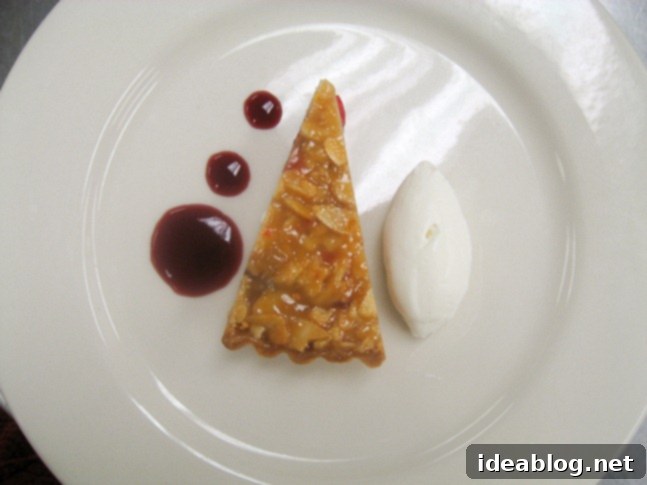
After a much-needed, albeit quick, lunch break, we swiftly transitioned back into the classroom. The afternoon session promised even more diverse learning, starting with the preparation of a classic terrine – essentially a sophisticated and often more elaborate form of pâté. Terrines are an art form in themselves, involving carefully layered ingredients, typically meats, vegetables, and sometimes foie gras, pressed and cooked in a specialized mold (the terrine dish itself) to create a beautiful, coherent block that is then chilled, sliced, and served. This requires precision in layering, a deep understanding of textures, and thoughtful pairing of flavors to achieve a harmonious result. Following this, we were treated to an eagerly anticipated demonstration on the creation of iconic French pastries, a true highlight of the day: croissants au beurre (the quintessential classic butter croissants), rich and delightful pain au chocolat, and a variety of other exquisitely filled croissants. The excitement in the room was palpable, especially with the promise of baking off some of these laminated masterpieces tomorrow morning for a truly indulgent breakfast!
I must admit, learning the art of making homemade croissants has been a personal culinary aspiration of mine for literally *years!* Good croissants, with their innumerable flaky layers, delicate crispness, and rich buttery aroma, are arguably my favorite pastry ever. So, to finally be initiated into the secrets of their creation was an incredibly exhilarating experience. While I don’t foresee myself whipping up batches of homemade croissants every single day – the process is undeniably labor-intensive, requiring patience, precise temperature control, and multiple rounds of laminating and folding the dough with butter – I am absolutely determined to attempt these for a special occasion in the very near future. The entire process, from preparing the détrempe (the base dough) to creating the beurre manié (the specific butter block for lamination) and executing the intricate folds, is a meticulous dance of science and artistry. The lamination process, where alternating layers of butter and dough are repeatedly folded, chilled, and rolled out, is what gives croissants their characteristic airy, honeycomb interior and their shattering crisp, golden exterior. Surprisingly, I found the shaping of the croissants to be one of the more challenging aspects, which I had initially underestimated. Achieving that perfect crescent shape, ensuring even distribution of layers, and maintaining the structural integrity of the delicate dough requires a finesse that only comes with practice and a keen eye. However, the sheer joy and satisfaction of seeing those golden, flaky pastries emerge from the oven make every single step of the effort well worth it, promising a rewarding treat for future endeavors!
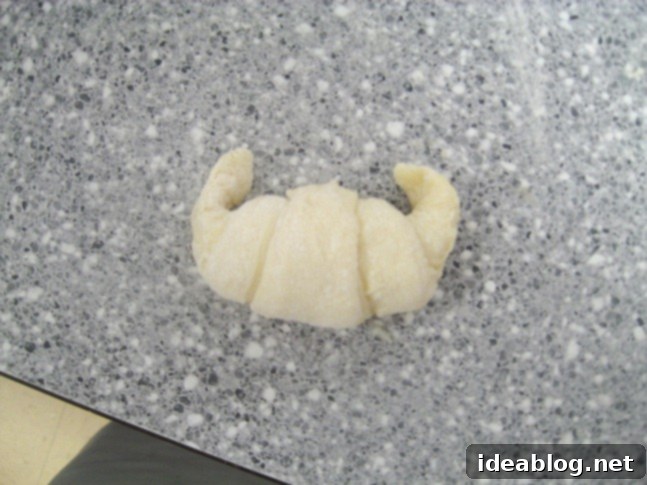
And now, with the day’s extensive lessons complete and my mind brimming with new knowledge and techniques, I am officially off to head home! The intensity of culinary school demands not just mental engagement but also physical stamina, and I’m hoping my persistent headache, likely a gentle reminder of inadequate hydration during our busy kitchen shifts, will have completely dissipated by morning. Ensuring proper hydration is certainly something I need to actively improve upon, especially as I look ahead to my upcoming externship, where the pace and demands will only intensify, requiring peak performance and self-care. This journey continues to teach me not just about the art and science of cooking, but also about the discipline, resilience, and self-care required to thrive in a professional culinary environment.
Here’s hoping I drift into slumber tonight, dreaming of those delicious, perfectly fresh-baked croissants – a sweet anticipation of tomorrow’s culinary adventures and the rewards of dedicated practice!
